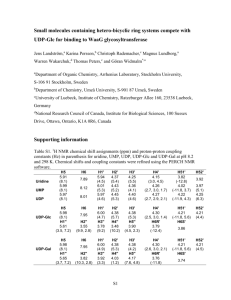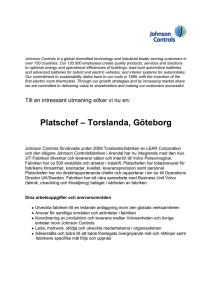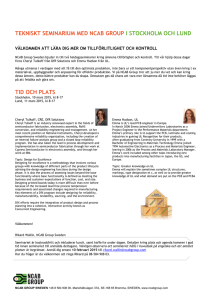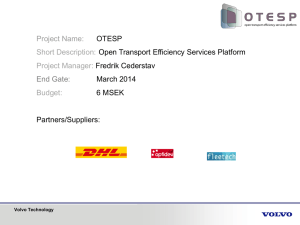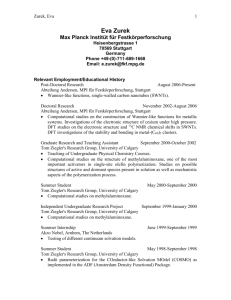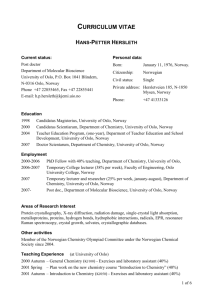Batteries for vehicles
advertisement
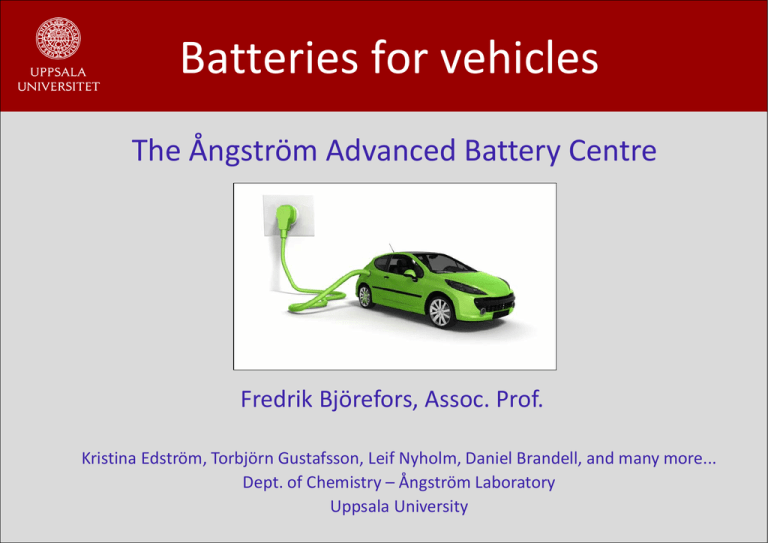
Batteries for vehicles The Ångström Advanced Battery Centre Fredrik Björefors, Assoc. Prof. Kristina Edström, Torbjörn Gustafsson, Leif Nyholm, Daniel Brandell, and many more... Dept. of Chemistry – Ångström Laboratory Uppsala University Batteries for vehicles Critical issues – A materials chemistry perspective Critical issues Performance: • energy driving range • rate, power acceleration (energy/time) • temperature -40 to +50 ˚C (ambient, rate) Fire during charging Safety issues Lifetime, cost ”En elbil tog eld medan den stod på laddning i ett parkeringshus i Helsingborg. Polisen misstänker inte att branden är anlagd.” Materials / abundance A lot of materials... 1 car ~200 kg battery small part electric vehicles: ~100 million tonnes! Li-ion batteries Materials/Performance: • anode (minus pole) • electrolyte • cathode (plus pole) Timeframe: materials 5-10 yrs, concepts 10-15 yrs Cathode part (plus pole) Cathode materials: Li2FeSiO4 (being commercialized) LiFeSO4F (rate) Li2FeP2O7 (high temperature) 3D mass transfer of Li-ions LiCoO2 Leads to a higher rate Cathode part (plus pole) Surface confined PEDOT coating of LiFeSO4F - Enhanced electronic conductivity. - Electron transfer from all-around Understanding and Controlling the Surface Chemistry of LiFeSO4F for an Enhanced Cathode Functionality Chem. Mater., 2013, 25 (15), pp 3020–3029 Adam Sobkowiak, Matthew R. Roberts, Reza Younesi, Tore Ericsson, Lennart Häggström, Cheuk-Wai Tai, Anna M. Andersson, Kristina Edström, Torbjörn Gustafsson, and Fredrik Björefors Li-ion Polymer Batteries for Electric Vehicles • Safety • Power/Energy Density • Lifetime, Cost • Scalability Bolloré Bluecar in Paris, 2011- Poly(trimethylene carbonate) • Thermally stable up to 200 oC • High dielectric constant • Mechanically robust • Wide electrochemical window B. Sun, J. Mindemark, K. Edström, D. Brandell, (2013) Solid State Ionics, DOI: 10.1016/j.ssi.2013.08.014. Anodes part (minus pole) Ageing at elevated temperature (22 and 55 ˚C, graphite/LiFePO4) Comparing Aging of MCMB Graphite/LiFePO4 cells at 22°C and 55°C. Electrochemical and Photoelectron Spectroscopy Studies. Submitted Hellqvist Kjell, Maria, Malmgren, Sara Ciosek, Katarzyna, Behm, Mårten, Edström, Kristina, Lindbergh, Göran Crystal structure of Li1.33Ti1.67O4 Promising anode material Results – Silicon anodes Surface chemistry X-ray spectroscopy • 15-25% higher energy density • Si-based Li-batteries soon on the market Voltage (V vs. Li/Li+) Si (nm) 2.5 Si/C C/20 2 1200 mAh/g 1.5 1 0.5 0 0 400 800 1200 Q (mAh/g) 1600 Li-battery development Energy density Li-air US DoE: 2020 Future ? Na-ion chemistry 2015 Li-S 2007 Organic cathodes 2005 A123 1995 Sony 1990 Sony Sony for vehicles Nano-electrodes 250 Wh/kg 800Wh/l Future ? Future ? New concepts • Lithium-sulfur batteries • Sodium-batteries • Organic electrodes • 3D-microbatteries Thank you... ... for listening! ... StandUP and many more ... contributing persons
